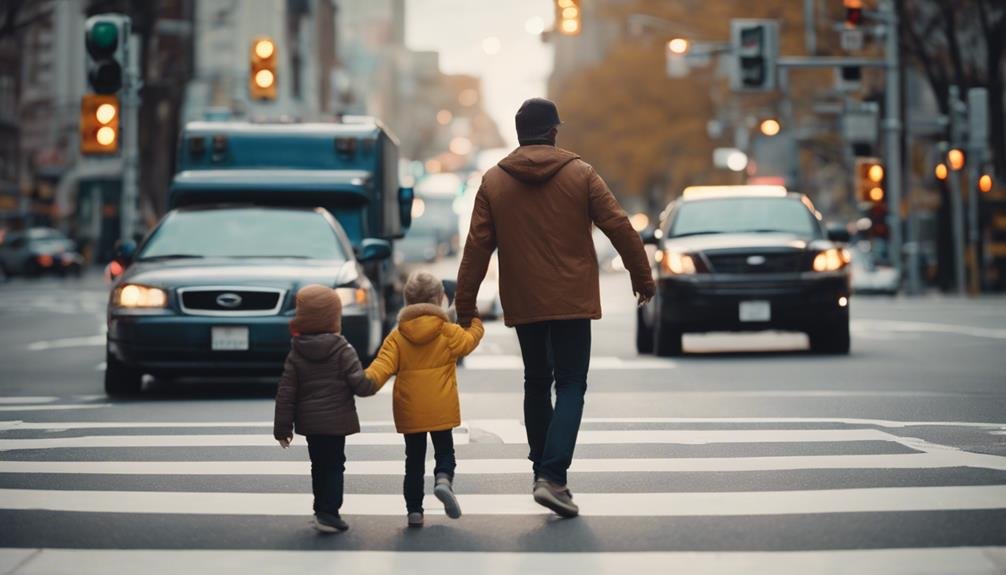"Cherishing Little Steps - A Haven for Baby and Family Journeys"
Teaching Your Child About Safety: Basic Tips and Strategies
Imagine your child moving through a maze, each turn presenting a potential hazard. Just like in that maze, the world is full of dangers for children.
You work hard to protect them, but empowering them with safety knowledge is equally important. As you guide your child through the basics of safety, from setting home rules to teaching road safety and stranger danger awareness, you equip them with the tools to move through life's maze confidently.
But how can you make sure they retain and apply this important information effectively?
Key Takeaways
- Establish clear safety rules at home to create a secure environment for your child.
- Teach road safety practices like using pedestrian crossings and wearing bike helmets for a safer experience.
- Educate your child about stranger danger awareness to empower them in unfamiliar situations.
- Discuss internet safety guidelines to ensure positive and secure online interactions for your child.
Importance of Safety Education

Understanding why safety education is important for children can make a substantial difference in preventing accidents and promoting well-being. When it comes to playground supervision, ensuring that children are playing in a safe environment is essential. By teaching kids about playground safety rules, such as not pushing others on swings or using equipment properly, you can help them avoid unnecessary injuries.
Pool safety is another critical aspect of child safety education. Educating children about the dangers of running near the pool, diving in shallow water, or swimming without adult supervision can greatly reduce the risk of accidents. By instilling these safety practices early on, you empower children to make informed decisions and protect themselves.
Setting Safety Rules at Home
To make certain a safe environment for your child, establish clear safety rules at home that promote a secure and nurturing atmosphere. Start by teaching your child about kitchen safety. Make sure they understand the dangers of sharp objects, hot surfaces, and how to safely handle kitchen appliances. Emphasize the importance of never leaving cooking food unattended and always using oven mitts when handling hot dishes.
Another important safety rule is practicing fire drills regularly. Teach your child how to react in case of a fire emergency, including how to escape the house safely and where to meet outside. Make the drills engaging by turning them into a game, but make sure your child understands the seriousness of the practice.
Teaching Road Safety

Practice safe habits when teaching your child about road safety to make sure they understand the importance of staying alert and cautious while moving through streets and crossings. Teach them to always use pedestrian crossings and to wait for traffic signals before crossing the road. Emphasize the significance of looking both ways, listening for oncoming vehicles, and only crossing when it's safe to do so. Encourage the use of bike helmets and reflective gear when cycling to increase visibility and guarantee their safety on the road.
Engage your child in practical road safety activities like walking together and pointing out potential hazards or discussing different road signs and their meanings. Role-playing scenarios where they practice crossing the street safely can also be beneficial. Encourage open communication about any concerns or questions they may have regarding road safety.
Practicing Stranger Danger Awareness
When teaching your child about practicing stranger danger awareness, encourage them to trust their instincts and seek help from trusted adults if they ever feel unsafe. Role playing scenarios can be a fun and effective way to teach your child how to handle encounters with strangers. Create different situations where your child has to make decisions about interacting with unfamiliar individuals. This hands-on approach can help them understand the importance of staying cautious.
Instruct your child on how to identify safe adults in their life. Teach them that safe adults are usually people they know well, like family members, teachers, or parents of friends. Remind your child that it's okay to ask for help from these trusted adults if they ever feel uncomfortable or threatened by a stranger.
Internet Safety Guidelines

Guarantee your child grasps the significance of establishing Internet safety guidelines to safeguard themselves online. The online world can be a wonderful place, but it's important for your child to understand how to navigate it safely. Here are some essential tips to make sure their online experiences are positive and secure:
- Privacy Protection: Teach your child the importance of keeping personal information such as full name, address, phone number, and school details private when interacting online.
- Cyberbullying Prevention: Discuss with your child the harmful effects of cyberbullying and encourage them to communicate with you if they experience any form of online harassment.
- Safe Online Communication: Emphasize the importance of being cautious when interacting with strangers online and encourage your child to only communicate with people they know in real life.
Emergency Preparedness Training
To guarantee your child's overall safety, it's important to equip them with essential Emergency Preparedness Training to handle unexpected situations effectively. Disaster preparedness is a vital skill for everyone, including children. By teaching your child about disaster preparedness, you're empowering them to stay safe in various emergencies. Start by creating a family emergency plan and practicing it regularly with your child. Make sure they know important contact numbers, evacuation routes, and safe meeting points.
Additionally, consider enrolling your child in a first aid training course. First aid training equips your child with the knowledge and skills to provide immediate assistance in case of injuries or emergencies. Teach them how to apply basic first aid techniques like applying bandages, performing CPR, and helping someone who's choking. Encourage your child to ask questions and seek clarification to make certain they understand the concepts well.
Frequently Asked Questions
How Can I Teach My Child About the Importance of Safety Without Scaring Them?
You can teach your child about safety by using role-playing scenarios and positive reinforcement techniques. Show them how to handle various situations calmly and confidently. Encourage good safety practices with praise and rewards to build their confidence.
What Are Some Creative Ways to Make Safety Rules Fun and Engaging for My Child at Home?
To make safety rules engaging at home, try role playing games and interactive apps. Get creative with storytelling and art projects. Keep it fun and interactive to help your child learn and remember important safety guidelines.
How Can I Help My Child Differentiate Between Safe and Unsafe Online Interactions?
To help your child differentiate between safe and unsafe online interactions, talk about online privacy and cyberbullying. Teach them about stranger danger and the importance of managing their digital footprint. Engage in open conversations and set clear boundaries.
Are There Specific Strategies for Teaching My Child About Emergency Preparedness Without Causing Anxiety?
When teaching your child about emergency preparedness, consider role playing scenarios to make learning fun and engaging. Use calm communication to explain the importance of being prepared without causing anxiety. It's a valuable life skill.
How Can I Address Potential Safety Concerns With My Child's Friends or Their Parents Without Creating Conflict?
When addressing concerns about safety with your child's friends or their parents, approach the topic with empathy and understanding. Open communication and honesty can help navigate potential conflicts, fostering better relationships and ensuring everyone's well-being is a top priority.
Conclusion
Remember, teaching your child about safety is like planting seeds of knowledge that will grow into a strong and resilient tree of protection.
By instilling these important lessons early on, you're ensuring that your child is equipped to navigate the world safely.
So continue to water these seeds with love, guidance, and practice, and watch as your child blossoms into a confident and aware individual who can confidently navigate any situation that comes their way.


